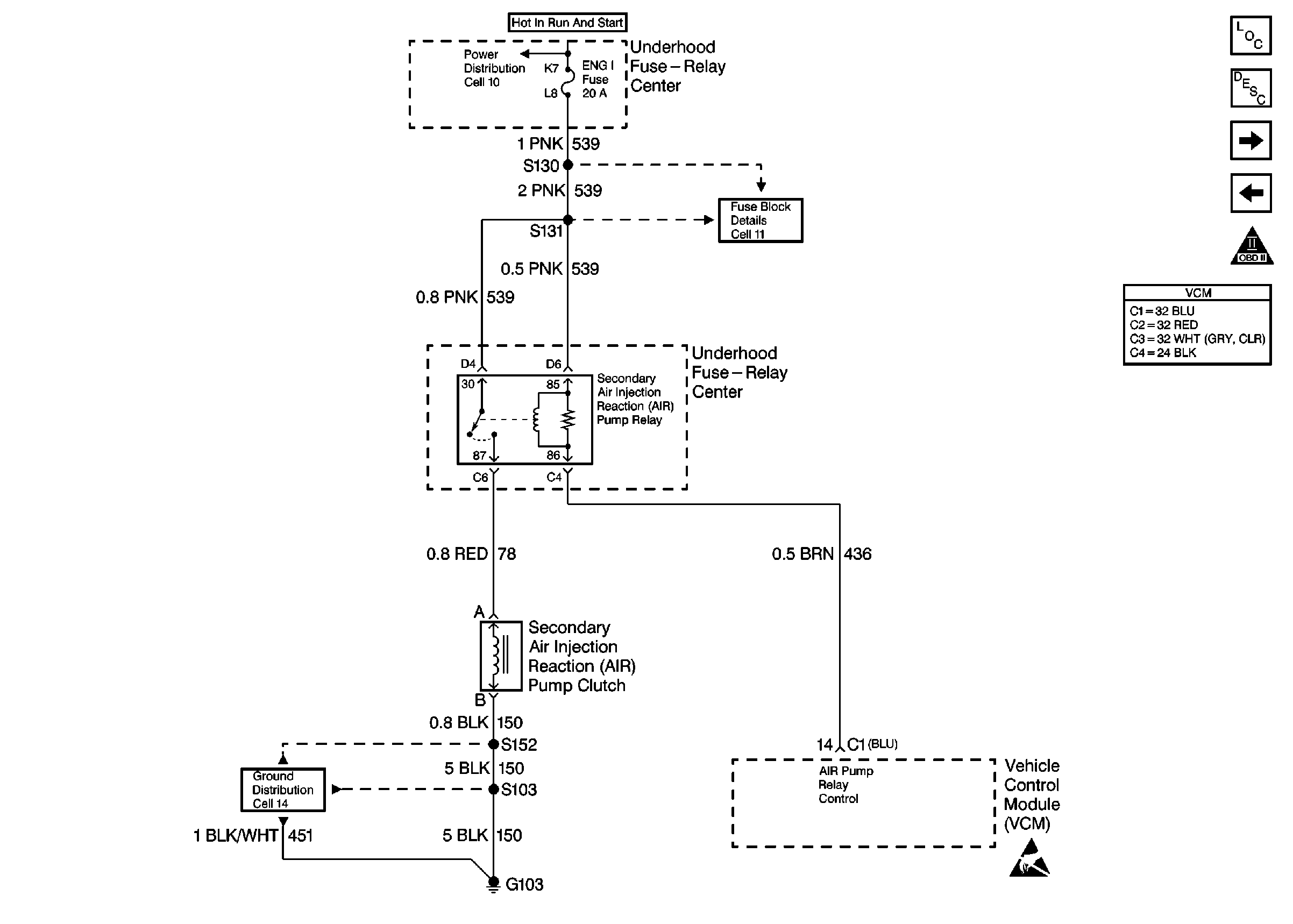Refer to Engine Controls Schematics
Cell 23: Secondary AIR Controls

.
Circuit Description
Fused ignition voltage is supplied to the AIR relay. The VCM controls the AIR pump by grounding the AIR relay control circuit. This energizes the relay and supplies voltage to the AIR pump clutch. When the fuel system goes to the Closed Loop mode, the VCM opens the ground to the AIR control circuit.
Conditions for Running the DTC
| • | No active ECT DTCs |
| • | No active IAC DTCs |
| • | No active HO2S DTCs |
| • | No active misfire DTCs |
| • | No active MAP sensor DTCs |
| • | No active fuel trim DTCs |
| • | No active EVAP DTCs |
| • | No active TP sensor DTCs |
| • | No active IAT DTCs |
| • | No active MAF DTCs |
| • | The system voltage is greater than 10 volts |
| • | The IAT is greater than 0°C(32°F). |
| • | The power enrichment mode is not active. |
| • | Decel fuel cut-off not active |
| • | The commanded air/fuel ratio is 14.7:1. |
| • | The engine speed is greater than 550 RPM. |
| • | The engine load is less than 50 %. |
| • | The MAF is less than 100 g/s. |
| • | The ECT is between 75°C and 105°C(167°F to 221°F). |
| • | The system has been in closed loop mode for more than 15 seconds. |
Conditions for Setting the DTC
The VCM has not detected a change in HO2S voltage and short term fuel trim when the secondary air injection pump is energized.
Action Taken When the DTC Sets
The VCM will turn ON the malfunction indicator lamp (MIL) after two consecutive test cycles with the fault active.
Conditions for Clearing the MIL or DTC
| • | The control module turns OFF the MIL after 3 consecutive drive trips when the test has run and passed. |
| • | A history DTC will clear if no fault conditions have been detected for 40 warm-up cycles. A warm-up cycle occurs when the coolant temperature has risen 22°C (40°F) from the startup coolant temperature and the engine coolant reaches a temperature that is more than 70°C (158°F) during the same ignition cycle. |
| • | Use a scan tool in order to clear the DTCs. |
Diagnostic Aids
Low AIR system volume may cause a DTC P1415, a DTC P1416 or an intermittent complaint. Also check for the following conditions:
| • | Pinched, kinked, or restricted AIR pipes, hoses, or fittings |
| • | Leaks, holes, loose fittings or hoses |
| • | Restricted or obstructed AIR pump inlet |
An air supply hose that is melted before the check valve could indicate exhaust gas back-flow past the check valve.
Test Description
The numbers below refer to the step numbers on the diagnostic table.
-
This step determines if the cause of this DTC is still present.
-
This step determines if there is a problem before or after the check valve.
Step | Action | Value(s) | Yes | No | ||||||||||
|---|---|---|---|---|---|---|---|---|---|---|---|---|---|---|
1 |
Important: Before clearing DTCs, use the scan tool Capture Info to save the Freeze Frame and the Failure Records for reference. The control module's data is deleted once the Clear Info function is used. Did you perform the Powertrain On-Board Diagnostic (OBD) System Check? | -- | ||||||||||||
Does the Short Term Fuel Trim Bank 2 indicate a change of more than the specified value within 30 seconds? | 16 % | |||||||||||||
3 | The DTC is intermittent. Are any additional DTCs stored? | -- | Go to the applicable DTC table | Go to Diagnostic Aids | ||||||||||
4 | Check the AIR System Bank 2 for the following:
Did you find a problem? | -- | ||||||||||||
Does air flow from the AIR hose? | -- | |||||||||||||
6 | Check for restrictions or leaks in the check valve and the AIR pipe on Bank 2. Did you find a problem? | -- | Go to Diagnostic Aids | |||||||||||
7 | Check for restrictions or leaks in the Bank 2 AIR hose between the check valve and the point where the system branches to each bank. Did you find a problem? | -- | ||||||||||||
8 | Repair as necessary. Refer to Secondary Air Injection Check Valve and Check Valve Pipe Replacement . Is the action complete? | -- | -- | |||||||||||
9 |
Does the scan tool indicate that the diagnostic Passed? | -- | ||||||||||||
10 | Does the scan tool display any additional undiagnosed DTCs? | -- | Go to the applicable DTC table | System OK |
